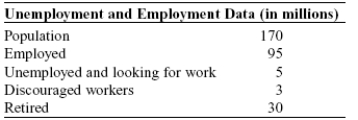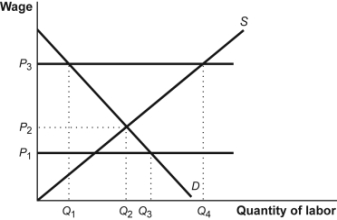A) can be secured only with the help of a labour union.
B) is one that causes greater frictional unemployment.
C) is offered by an employer to encourage workers to work harder.
D) results in a less productive work force.
F) B) and C)
Correct Answer

verified
Correct Answer
verified
True/False
If the government increases the length and amount of unemployment benefits,the unemployment rate will fall.
B) False
Correct Answer

verified
Correct Answer
verified
Multiple Choice
Frictional unemployment:
A) occurs only during expansions.
B) is due to time workers spend in job search.
C) is the difference between cyclical unemployment and the natural rate of unemployment.
D) hasn't occurred since the 1930s.
F) B) and C)
Correct Answer

verified
Correct Answer
verified
Multiple Choice
Scenario: Employment in Xenia Xenia has 10 000 people.Of this population,1 000 residents are below age 15,and 2 000 have given up looking for work.Currently,500 people are unemployed but are actively looking for work;2 500 work part time,and the rest are fully employed. What is the unemployment rate?
A) 7.14%
B) 4.25%
C) 11.11%
D) 2%
F) C) and D)
Correct Answer

verified
Correct Answer
verified
Multiple Choice
The costs that arise from the way inflation makes money a less reliable unit of measurement are:
A) shoe-leather costs.
B) menu costs.
C) unit-of-account costs.
D) medium of exchange costs.
F) All of the above
Correct Answer

verified
Correct Answer
verified
Multiple Choice
Which statement about unemployment is FALSE?
A) Unemployment always falls during recessions.
B) Unemployment always falls during expansions.
C) There is a strong negative relation between growth in real GDP and changes in unemployment.
D) In general,there is a trade-off between inflation and unemployment in the short run.
F) C) and D)
Correct Answer

verified
Correct Answer
verified
Multiple Choice
If the actual unemployment rate is 7% and the cyclical unemployment rate is 2%,then the natural rate of unemployment is:
A) 2%.
B) 5%.
C) 7%.
D) 9%.
F) C) and D)
Correct Answer

verified
Correct Answer
verified
Multiple Choice
A wage offered by an employer as an incentive for more work effort and performance and that exceeds the equilibrium wage rate is known as a(n) _____ wage.
A) minimum
B) equilibrium
C) efficiency
D) union
F) A) and D)
Correct Answer

verified
Correct Answer
verified
Multiple Choice
An example of the frictionally unemployed is a(n) :
A) autoworker who is temporarily laid off because of a decline in sales.
B) geologist who is permanently laid off from an oil company because of a technological advance.
C) worker at a fast-food restaurant who quits work and attends university.
D) real estate agent who leaves a job in Montreal and searches for a similar,higher paying job in Toronto.
F) A) and C)
Correct Answer

verified
Correct Answer
verified
Multiple Choice
Use the following to answer questions:  -(Table: Unemployment and Employment Data) Use Table: Unemployment and Employment Data.If marginally attached workers are included,the labour force in this economy is _____ million.
-(Table: Unemployment and Employment Data) Use Table: Unemployment and Employment Data.If marginally attached workers are included,the labour force in this economy is _____ million.
A) 170
B) 103
C) 100
D) 98
F) A) and C)
Correct Answer

verified
Correct Answer
verified
Multiple Choice
If there are 100 million people in the total population,a labour force of 50 million,and 47 million employed workers,the unemployment rate is _____%.
A) 3
B) 6
C) 8
D) 10
F) B) and D)
Correct Answer

verified
Correct Answer
verified
Multiple Choice
Costs of inflation do NOT include _____ costs.
A) menu
B) shoe-leather
C) unit-of-account
D) efficiency-wage
F) A) and C)
Correct Answer

verified
Correct Answer
verified
Multiple Choice
Suppose that the real interest rate is 2.1% and the nominal interest rate is 5.4%.The inflation rate is _____%.
A) 7.5
B) 3.3
C) -3.3
D) 2.1
F) None of the above
Correct Answer

verified
Correct Answer
verified
Multiple Choice
A person who is NOT working or looking for work is:
A) included in the unemployment rate.
B) underemployed.
C) a member of the labour force who is not working.
D) not counted in the unemployment rate.
F) None of the above
Correct Answer

verified
Correct Answer
verified
Multiple Choice
The sum of the frictional and structural rates of unemployment is the:
A) cyclical rate of unemployment.
B) cyclical rate of employment.
C) natural rate of unemployment.
D) natural rate of employment.
F) A) and C)
Correct Answer

verified
Correct Answer
verified
Multiple Choice
To be officially unemployed,a person must:
A) not have a job and must have looked for work in the past 4 weeks.
B) be under 55 years old.
C) be working fewer than 30 hours per week.
D) be working fewer than 20 hours per week.
F) B) and C)
Correct Answer

verified
Correct Answer
verified
Multiple Choice
Use the following to answer questions:  -(Figure: The Minimum Wage) Use Figure: The Minimum Wage.What is the quantity of labour demanded at a binding minimum wage of P3?
-(Figure: The Minimum Wage) Use Figure: The Minimum Wage.What is the quantity of labour demanded at a binding minimum wage of P3?
A) Q1
B) Q2
C) Q3
D) Q4
F) A) and C)
Correct Answer

verified
Correct Answer
verified
Multiple Choice
Natural unemployment equals _____ unemployment plus _____ unemployment.
A) frictional;structural
B) cyclical;structural
C) frictional;cyclical
D) frictional;both structural and cyclical
F) None of the above
Correct Answer

verified
Correct Answer
verified
Multiple Choice
One factor that raises the natural rate of unemployment is:
A) a population boom that increases the number of young workers joining the labour force.
B) the loss of labour union membership across industries.
C) the loss of retirement funds so that more people in the baby-boom generation continue to work past the typical retirement age.
D) the use of new technology in the workplace that increases labour productivity.
F) All of the above
Correct Answer

verified
Correct Answer
verified
True/False
A high unemployment rate implies a high level of GDP.
B) False
Correct Answer

verified
Correct Answer
verified
Showing 101 - 120 of 332
Related Exams